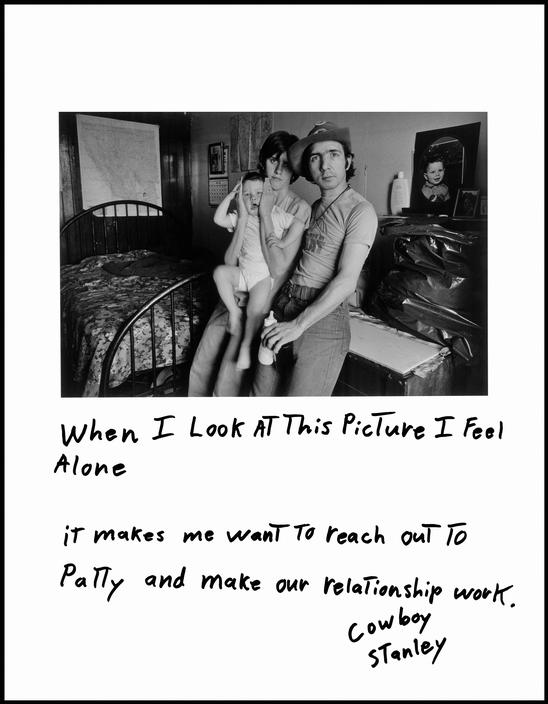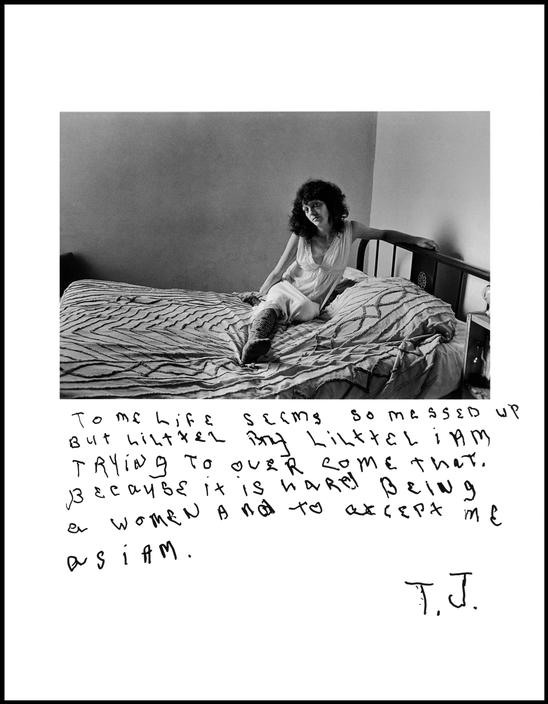
Image Credit: Magnum Photos
Jim Goldberg's Rich and Poor features photographs of the impoverished tenants of a San Fransisco hotel and of an affluent group of select individuals, also shown in their homes. As the most obvious dimension of the title suggests, the photos serve as a comparative essay on class and the disparity of wealth in America. Goldberg compiled this collection through the late 70s and early 80s and it was originally published by Random House in 1985. The Harry Ransom Center's current exhibit, Radical Transformation: Magnum Photos into the Digital Age (September 10, 2013 – January 5, 2014), includes several images from Rich and Poor.
As I walked through the exhibit, alternately admiring the pieces and feeling guilty for not knowing enough about photography to be properly appreciative, Goldberg's work in particular caught my eye. The composition of these pieces is, in and of itself, visually striking: a black-and-white photo is surrounded by white space marked with heavy, black, handwritten text. The presence of text has interesting implications for meaning as well. As I read through the testimonies attached to the images, I found myself compelled to think about the ethics of photojournalism and the limits of visual media. My encounter with each piece unfolded dynamically, and reading the text after carefully taking in the images led me to reflect on my role as detached observer with no little amount of distaste. For instance, while I closely examined the image of the piece signed “T.J,” my geared-for-interpretation-brain zeroed in on the woman's not-quite-sexy pose, the tilt of her head, the flatness of her stare, the bed as the only other notable feature in the frame.

Image Credit: Magnum Photos
I cobbled together something about female sexuality and kept idly wondering whether this picture was trying to challenge norms or partake of them while I read through the text. It says, “To me Life seems so messed up But lilttel by lilttel i am trying to over come that. Because it is hard being a woman and to accept me as I am. T.J.” This visceral commentary caused me to be immediately overcome with the insufficiency of any interpretation I could possibly bring to bear on this photo. The model herself, with her intimate, affective link to the creation of this image, to the experiences the photo gestures towards, to the reasons behind the tilt of the head, the pose, the bed, had already asserted an incredibly rich analysis of this image, and any others paled in comparison. All of a sudden, Rich and Poor acquired new, media-oriented dimensions for me. The richness of the images grew poor against the force of the models' statements. The poverty of my own understanding as a viewer came into harsh relief.
Of course, this striking experience itself was carefully tailored by Goldberg, with the help of his models. I have yet to read through Rich and Poor, but, from what I've gleaned off the internet, I understand that the statements on the photos were hand-chosen by Goldberg, and the authenticity of the handwriting, suggestive of a spontaneous overflow of emotion, itself is an artistic technique. However, Goldberg's collection still asks viewers to examine their own privilege and think hard about both financial and artistic exploitation.
The opinions expressed herein are solely those of viz. blog, and are not the product of the Harry Ransom Center.


Recent comments
2 years 29 weeks ago
2 years 44 weeks ago
2 years 44 weeks ago
2 years 50 weeks ago
3 years 4 weeks ago
3 years 4 weeks ago
3 years 4 weeks ago
3 years 6 weeks ago
3 years 6 weeks ago
3 years 6 weeks ago